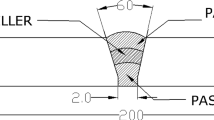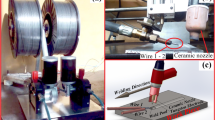Abstract
This paper develops an automatic welding control system which uses a genetic algorithm to carry out external noise cancellation and compensation. In the proposed approach, the genetic algorithm is used to identify the polynomial form or parameters of the external force or disturbance, including the amplitude, frequency and phase to compensate for nonlinear phenomenon such as disturbance in the mechanical system. In compensating for the nonlinear phenomenon, a piecewise linearization of the approximation polynomial is performed and the genetic algorithm optimization process is then used to identify the parameters of the polynomial function. The simulation and experimental results confirm that the proposed automatic welding control system provides an effective means of compensating for the effects of the external force or disturbance and therefore results in an enhanced welding performance.
Similar content being viewed by others
Abbreviations
- a :
-
Friction damping coefficient of electrode feed-rate mechanism
- se :
-
Steady state error
- r :
-
Reference input
- y :
-
System output
- na :
-
Number of poles of ARX model to be identified
- nb :
-
Number of zeros plus one of ARX model to be identified
- nk :
-
Identification delay
- J :
-
Total inertia of electrode feed-rate mechanism
- k i :
-
Coefficient ratio of melting rate to arc current
- k u :
-
Coefficient ratio of melting rate to arc voltage
- v f :
-
Electrode feed rate
- v m :
-
Electrode melting rate
- K d :
-
Derivative gain of PID controller
- K i :
-
Integral gain of PID controller
- K p :
-
Proportional gain of PID controller
- K u :
-
Oscillation gain at stability limit under P-controller
- K t :
-
Motor constant of electrode feed-rate mechanism
- T u :
-
Period of oscillation at stability limit under P-controller
- U a :
-
Arc voltage
- C(s):
-
Controller of welding control system
- E(s):
-
Error signal of reference input I r (s) and welding current I a .
- G(s):
-
Control plant of welding control system
- H(s):
-
Current sensor of welding control system
- U(s):
-
Output signal of current controller
- I a (s):
-
Transfer-function of arc current I a of welding control system
- I r (s):
-
Transfer-function of reference input I r (s)of welding control system
References
Baker, J. E. (1985). Adaptive selection methods for genetic algorithms. Proc. Int. Conf. Genetic Algorithms and Their Applications (pp. 101–111).
Bauchspiess A., Absi Alfaro S.C., Dobrzanski L.A. (2001) Predictive sensor guided robotic manipulators in automated welding cells. Journal of Materials Processing Technology 109(1): 13–19
Canudasde Wit C., Olsson H., Astrom K.J., Lischinsky P. (1995) A new model for control of systems with friction. Proceedings of IEEE Transactions on Automatic Control 40(3): 419–425
Chen W.H. (2004) Disturbance observer based control for nonlinear systems. Proceedings of IEEE/ASME Transactions on Mechatronics 9(4): 706–716
Chen X., Komada S., Fukuda T. (2000) Design of a nonlinear disturbance observer. Proceeding of IEEE Transactions on Industrial Electrics 47(2): 429–437
Friedland B., Park Y.J. (1992) On adaptive friction compensation. Proceeding of IEEE Transactions on Automatic Control 37(10): 1609–1612
Goldberg D.E. (1989) Genetic Algorithms in search, optimization and machine learning. Reading, MA, Addsion-Wesley
Ha, Q. P., Rye, D. C., & Druuant-Whyte, H. F. (2000). Variable structure systems approach to friction estimation and compensation. In Proc. IEEE International Conference on Robotics and Automation (pp. 3543–3548). San Francisco, CA.
Holland, J. H. (1975). Adaptation in neural and artificial systems. Ann Arbor, MI: Univ. Mich. Press.
Howard B.C. (1979) Modern welding technology. Prentice-Hall, Inc., Englewood Cliffs
Hu T.S. (1994) Arc welding (2nd edn.). Peking, China, Machine Industrial Book Co.
Huang X., Chen S.B. (2006) SVM-based fuzzy modeling for the arc welding process. Materials Science and Engineering A-Structural Materials Properties Microstructure and Processing 427(1): 181–187
Huang Y., Messner W. (1998) A novel disturbance observer design for magnetic hard drive servo system with a rotary actuator. Proceedings of IEEE Transactions on Magnetic 34(4): 1892–1894
Iwasaki M., Shibata T., Matsui N. (1999) Disturbance-observer-based nonlinear friction compensation in table drive system. Proceedings of IEEE/ASME Transactions on Mechatronics 4(1): 3–8
Khalil, H. K. (2000). Nonlinear systems. Prentice-Hall.
Kim E. (2002) A fuzzy disturbance observer and its application to control. Proceedings IEEE Transactions on Fuzzy Systems 10(1): 77–84
Kim B.K., Chung W.K. (2003) Advanced disturbance observer design for mechanical positioning systems. Proceeding of IEEE Transactions on Industrial Electrics 50(6): 1207–1216
Komada S., Machii N., Hori T. (2000) Control of redundant manipulators considering order of disturbance observer. Proceedings of IEEE Transactions on Industrial Electrics 47(2): 413–420
Meran C. (2006) Prediction of the optimized welding parameters for the joined brass plates using genetic algorithm. Materials and Design 27(5): 356–363
Pan T.T., Chung T.L., Ngo M.D., Kim H.K., Kim S.B. (2005) Decentralized control design for welding mobile manipulator. Journal of Mechanical Science and Technology 19(3): 756–767
Senjyu T., Kashiwagi T., Uezato K. (2001) Position control of ultrasonic motors using MRAC with dead-zone compensation. Proceedings of IEEE Transactions on Industrial Electrics 48(6): 1278–1285
Smith, D. (1989). Welding skills and technology. McGraw-Hill Book Co.
Tan Y., Chang J., Tan H. (2003) Adaptive backstepping control and friction compensation for ac servo with inertia and load uncertainties. Proceedings IEEE Transactions on Industrial Electrics 50(5): 944–952
Verdelho P., Silva M.P., Margato E., Esteves J. (1998) An electronic welder control circuit. IEEE International Conference, Industrial Electronics Society 2: 612–617
Wang Y.W., Chen Q. (2002) On-line quality monitoring in plasma-arc welding. Journal of Materials Processing Technology 120(1): 270–274
Yamamoto H. (1990) The development of welding control system for spatter reduction. Welding International 4(5): 398–403
Yamane S., Sharif L.H., Zeniya S., Oshima K. (2005) Feed forward control of back bead and bead height in narrow gap robotic welding. Science and Technology of Welding and Joining 10(1): 23–26
Zhang Y.M., Liu Y.C. (2003) Modeling and control of quasi-keyhole arc welding process. Control Engineering Practice 11(12): 1401–1411
Zhang, Y. S., Chen, G. L., & Lin, Z. Q. (2004). Study on weld quality control of resistance spot welding using a neuro-fuzzy algorithm. In Intelligent Information and Engineering Systems, PT 3, Proceedings Lecture Notes in Artificial Intelligence 3215 (pp. 544–550).
Zhang Y.M., Liguo E., Walcott B.L. (1998) Interval model based control of gas metal arc welding. IEEE International Conference, American Control Conference 3: 1752–1756
Zheng Y.T., Hang S.S. (1987) Arc welding power supply (2nd edn.). Peking, China, Machine Industrial Book Co.
Zhou L., Lin T., Chen S.B. (2006) Autonomous acquisition of seam coordinates for arc welding robot based on visual servoing. Journal of Intelligent and Robotic Systems 47(3): 239–255
Author information
Authors and Affiliations
Corresponding author
Rights and permissions
About this article
Cite this article
Wu, CY., Tung, PC. Application of genetic algorithm to external noise cancellation and compensation in automatic arc welding system. J Intell Manuf 19, 249–256 (2008). https://doi.org/10.1007/s10845-008-0078-4
Received:
Accepted:
Published:
Issue Date:
DOI: https://doi.org/10.1007/s10845-008-0078-4




